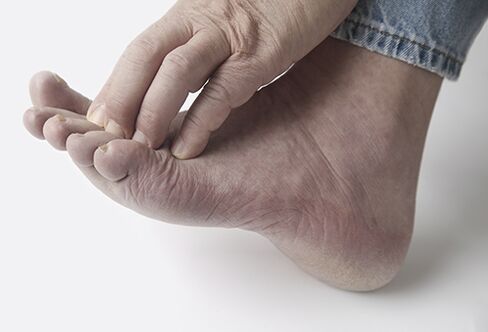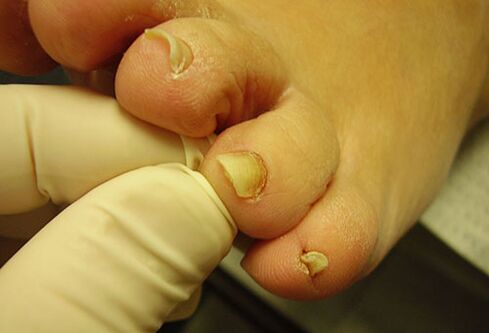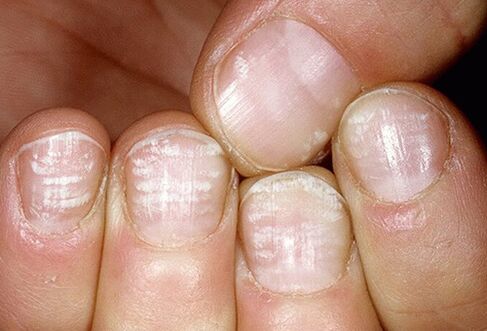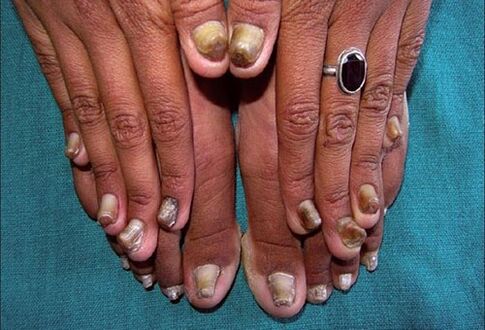Nail fungus can not be confused with anything in the advanced stage, when it is almost impossible to cure. But if you know the previous symptoms of nail fungus, then it will not be too late to start fighting the infection and nail loss can be avoided quite well. But in different cases, the fungus looks different, so first you need to understand a little about the nature and course of the disease.

General signs of the disease
Regardless of the type of fungus, variety, course of the disease and even the stage, these symptoms will remain unchanged and will definitely indicate a developing or already developing onychomycosis.
- A change in the color of the nail plate is a major sign from which the disease begins to develop. Shades can range from white to black, but the most common color of mushroom nails is yellow-brown.
- An unpleasant odor always accompanies onychomycosis, although it may not be very noticeable in the initial stages. True, you will hardly smell on your feet, and a specific smell will become apparent already at the stage of disease development.
- Exfoliation, crumbling and peeling of the nail plate does not start right away, but it is these signs of nail fungus that make most people sound the alarm. If these symptoms are moderately expressed and appear locally, then there is still the possibility of restoring a healthy appearance to the nail.
- Painful sensations rarely appear in the initial stage and developmental stage, but as the disease progresses, discomfort and pain can not be avoided: in any case, they will appear either due to deformation, or due to a ruined nail plate, or due to the onset of purulent inflammation.
- Burning and itching of the skin should also not be ignored. Moreover, in the initial stage, it is these symptoms that can help in recognizing the disease because in some cases it passes to the nail plate from the skin to the crests or lateral or posterior cuticles.
By the way
Onychomycosis is much more common on toenails, while the fungus falls on the hands much less frequently, more often after contact with affected nails.

Symptoms of foot fungus
It seems that you already know how to identify nail fungus, but this information is quite general, although it will help in the accurate diagnosis of onychomycosis. The fact is that there are more than 50 types of fungi that can cause it, and about 10 of the course of the disease. It is better to know what awaits you in each of the possible scenarios in advance.
More than 90% of all cases of foot onychomycosis infection are due to dermatomycetes, slightly less than 10% - from yeast-like fungi, and only a small fraction - from fungal fungi.
Different types of nail fungus give different symptoms.
- With a normotrophic fungus, the nail plate itself is not deformed, and the most obvious manifestation of the disease is a change in the color of the plate on the sides in yellow-brown. At the same time, its thickness does not change, it does not crumble and the natural shine does not disappear. If you do not treat the normotrophic fungus, it will affect a growing area, the plaque will start to fall off and may come off completely.
- Hypertrophic fungi provoke a thickening of the nail plate, leading to the formation of growths that look like claws. In the advanced stage, such a fungus causes discomfort and often pain while walking and, of course, nail damage is accompanied by a change in color to gray or yellow. Such nails lose their natural shine and begin to crumble and melt.
- If you are faced with an atrophic fungus, then the risk of losing plaque without proper treatment is extremely high. Such a fungus gradually destroys the nail plate, making it loose and exfoliating, as a result of which its atrophy occurs. In the initial stages, it is difficult to distinguish an atrophic course, as it is accompanied only by a loss of brightness and a change in the color of the plaque to yellow, brown or gray.
Less typical are lateral-distal fungus with blackening of the nail plate, pain, suffocation and atrophy of the nail plate in the advanced stage; a proximal fungus with white spots in the area of growth and damage to the nail plate by the cuticle, as well as a superficial white fungus, which manifests itself in the form of small white spots on the nail, gradually growing andoccupy a growing area.
By the way
The older the person, the more susceptible to fungal nail diseases. Also, the appearance of fungi can be influenced by climate, hygiene and gender.

Symptoms of fungus on the hands
On the hands, the 3 main variants of the course of the disease do not differ from those encountered on the feet, only the distribution of the causes of occurrence is somewhat different: approximately 30% and 45% are due to dermatomycetes and yeasts. fungi, respectively, slightly less than 15% are mold, and also a small number of infections are caused by other fungal organisms.
The main symptoms are also the same for plaques on the arms and legs, and the affected areas look similar. The only difficult point may be the question of how to recognize nail fungus in less common cases, like infection with rubromycosis or trichophytons, but this is more of a task for qualified physicians.

Mushroom advancement
If in the initial stage the disease does not seem frightening and thoughts of serious treatment are seldom visited, being increasingly replaced by popular methods, then in an advanced stage it will not be possible to do without long-term medical treatment. And will not even be able to guarantee that the nail will stay with you.
- It would be ideal to start treatment of the disease at an early stage, but it is almost impossible to determine outside the laboratory: all the symptoms have a barely noticeable manifestation. Although some signs can still be seen. If you notice something that does not go well with the skin, for example, cracks, blisters or burns may appear, this is a clear vanguard of onychomycosis on the nails. If you see that the color of the nail plate has started to change along the edges or from one edge, this is also a cause for concern.
- Usually, the fungus becomes visible at the developmental stage, and to notice it as soon as possible, you should regularly do at least one simple pedicure and monitor the condition of the nails and the skin of the feet. During this period, the nail plate looks unhealthy, loses its luster, begins a significant change in color and closer to the beginning of the advanced stage, the nails begin to deform, peel and crumble.
- At an advanced stage, the nail will definitely actively collapse: it is delaminated, detached, loosened until the total destruction of the nail plate and even damage to the nail bed. For the disease to reach its advanced form, it must be ignored for quite some time, enduring itching, discomfort, disgusting appearance, and unpleasant odor, which people still do not do often. Therefore, this stage is typical for the rapid development of fungi in old age or in the presence of certain diseases.
It is important to remember that untreated nail fungus can turn into toenail fungus and this disease is even more uncomfortable and difficult to treat.
It is not so difficult to determine the presence of a fungus on the nails at least in the developmental stage, but it is better to trust qualified professionals to determine the cause and type of course. Do not neglect the help of doctors and contact them at the first suspicion of a disease.
























